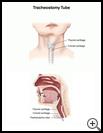
Tracheostomy
________________________________________________________________________
KEY POINTS
- A tracheostomy is surgery to make a small opening through the front of your neck and into your windpipe (trachea). A tube is then placed through the opening and into your windpipe. The tube keeps your airway open and helps you breathe by allowing air to flow into and out of your lungs.
- A tracheostomy may be done as an emergency or as a planned procedure. It may be temporary or you may have it for life. You may have this surgery if you have an injury or condition that makes it hard for you to breathe.
- Ask your provider how long it will take to recover and how to take care of yourself at home.
________________________________________________________________________
What is a tracheostomy?
A tracheostomy is surgery to make a small opening through the front of your neck and into your windpipe (trachea). A tube is then placed through the opening and into your windpipe. The tube keeps your airway open and helps you breathe by allowing air to flow into and out of your lungs.
The terms tracheostomy, tracheotomy, and trach may be used to refer to both the surgical procedure and to the opening created by the procedure.
When is it used?
A tracheostomy may be done when you have a problem with your airway. For example, it may be done if:
- You have an injury or a condition that makes it hard to breathe, cough up the mucus in your airways, or swallow.
- You will be on a breathing machine for a long time.
A tracheostomy may be done as an emergency or as a planned procedure. It may be temporary or you may have it for life.
How do I prepare for this procedure?
- Find someone to give you a ride home after the procedure or after your hospital stay. Allow for time to rest and try to find other people to help with your day-to-day tasks while you recover.
- You may or may not need to take your regular medicines the day of the procedure. Tell your healthcare provider about all medicines and supplements that you take. Some products may increase your risk of side effects. Ask your healthcare provider if you need to avoid taking any medicine or supplements before the procedure.
- Tell your healthcare provider if you have any food, medicine, or other allergies such as latex.
- Your healthcare provider will tell you when to stop eating and drinking before the procedure. This helps to keep you from vomiting during the procedure.
- Follow your provider's instructions about not smoking before and after the procedure. Smokers may have more breathing problems during the procedure and heal more slowly. It’s best to quit 6 to 8 weeks before surgery.
- Follow any other instructions your healthcare provider gives you.
- Ask any questions you have before the procedure. You should understand what your healthcare provider is going to do. You have the right to make decisions about your healthcare and to give permission for any tests or procedures.
What happens during the procedure?
This procedure is usually done in a hospital. In rare cases, it may be done at the scene of an accident.
You will be given medicine called anesthesia to keep you from feeling pain. Depending on the medicine, you may be awake or asleep during the procedure.
Your healthcare provider will make a cut in the front of your neck and into the windpipe. Your provider will then put a tube through the cut and into the windpipe. The tube will be held in place with stitches and cloth ties or Velcro straps that go around your neck. The stitches will be removed later.
Your provider may connect a breathing machine to the tracheostomy tube.
What happens after the procedure?
Depending on your condition, you may stay in the hospital for a few days or weeks. If you will still have the trach when you go home from the hospital, your healthcare provider will teach you or your caregiver how to care for it.
If you no longer need the trach after a time, your healthcare provider will remove the tube and allow the opening to close on its own. If the opening hasn’t closed by itself in 4 to 6 months, your provider may close it with minor surgery.
Follow your healthcare provider's instructions. Ask your provider:
- How long it will take to recover
- If there are activities you should avoid and when you can return to your normal activities
- How to take care of yourself at home
- What symptoms or problems you should watch for and what to do if you have them
Make sure you know when you should come back for a checkup. Keep all appointments for provider visits or tests.
What are the risks of this procedure?
Every procedure or treatment has risks. Some possible risks of this procedure include:
- You may have problems with anesthesia.
- You may have infection or bleeding.
- You may have damage to your voice box or problems with swallowing.
Ask your healthcare provider how the risks apply to you. Be sure to discuss any other questions or concerns that you may have.

